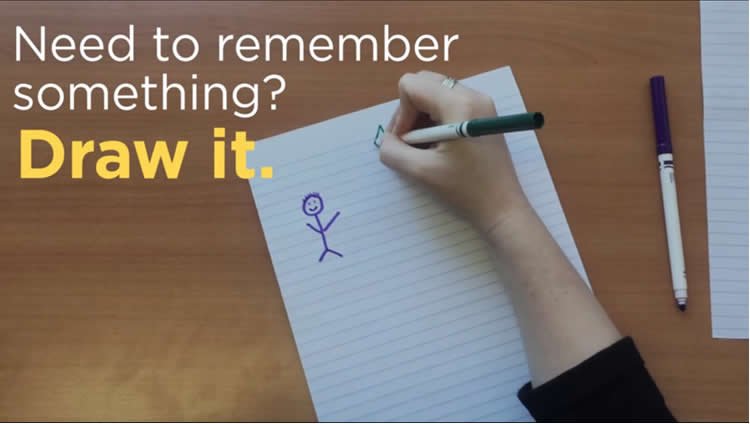Researchers at the University of Waterloo have found that drawing pictures of information that needs to be remembered is a strong and reliable strategy to enhance memory.
“We pitted drawing against a number of other known encoding strategies, but drawing always came out on top,” said the study’s lead author, Jeffrey Wammes, PhD candidate in the Department of Psychology. “We believe that the benefit arises because drawing helps to create a more cohesive memory trace that better integrates visual, motor and semantic information.”
The study, by Wammes, along with fellow PhD candidate Melissa Meade and Professor Myra Fernandes, presented student participants with a list of simple, easily drawn words, such as “apple.” The students were given 40 seconds to either draw the word, or write it out repeatedly. They were then given a filler task of classifying musical tones to facilitate the retention process. Finally, the researchers asked students to freely recall as many words as possible from the initial list in just 60 seconds.
The study appeared in the the Quarterly Journal of Experimental Psychology.
“We discovered a significant recall advantage for words that were drawn as compared to those that were written,” said Wammes. “Participants often recalled more than twice as many drawn than written words. We labelled this benefit ‘the drawing effect,’ which refers to this distinct advantage of drawing words relative to writing them out.”

In variations of the experiment in which students drew the words repeatedly, or added visual details to the written letters, such as shading or other doodles, the results remained unchanged. Memory for drawn words was superior to all other alternatives. Drawing led to better later memory performance than listing physical characteristics, creating mental images, and viewing pictures of the objects depicted by the words.
“Importantly, the quality of the drawings people made did not seem to matter, suggesting that everyone could benefit from this memory strategy, regardless of their artistic talent. In line with this, we showed that people still gained a huge advantage in later memory, even when they had just 4 seconds to draw their picture,” said Wammes.
Researchers at the University of Waterloo have found that drawing pictures of information that needs to be remembered is a strong and reliable strategy to enhance memory.
While the drawing effect proved reliable in testing, the experiments were conducted with single words only. Wammes and his team are currently trying to determine why this memory benefit is so potent, and how widely it can be applied to other types of information.
Source: Nick Manning – University of Waterloo
Image Source: The image is adapted from the University of Waterloo video.
Video Source: The video is credited to U. Waterloo.
Original Research: Full open access research for “The drawing effect: Evidence for reliable and robust memory benefits in free recall” by Jeffrey D. Wammes, Melissa E. Meade and Myra A. Fernandes in Quarterly Journal of Experimental Psychology. Published online February 16 2016 doi:10.1080/17470218.2015.1094494
Abstract
The drawing effect: Evidence for reliable and robust memory benefits in free recall
In 7 free-recall experiments, the benefit of creating drawings of to-be-remembered information relative to writing was examined as a mnemonic strategy. In Experiments 1 and 2, participants were presented with a list of words and were asked to either draw or write out each. Drawn words were better recalled than written. Experiments 3–5 showed that the memory boost provided by drawing could not be explained by elaborative encoding (deep level of processing, LoP), visual imagery, or picture superiority, respectively. In Experiment 6, we explored potential limitations of the drawing effect, by reducing encoding time and increasing list length. Drawing, relative to writing, still benefited memory despite these constraints. In Experiment 7, the drawing effect was significant even when encoding trial types were compared in pure lists between participants, inconsistent with a distinctiveness account. Together these experiments indicate that drawing enhances memory relative to writing, across settings, instructions, and alternate encoding strategies, both within- and between-participants, and that a deep LoP, visual imagery, or picture superiority, alone or collectively, are not sufficient to explain the observed effect. We propose that drawing improves memory by encouraging a seamless integration of semantic, visual, and motor aspects of a memory trace.
“The drawing effect: Evidence for reliable and robust memory benefits in free recall” by Jeffrey D. Wammes, Melissa E. Meade and Myra A. Fernandes in Quarterly Journal of Experimental Psychology. Published online February 16 2016 doi:10.1080/17470218.2015.1094494







